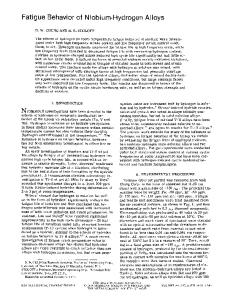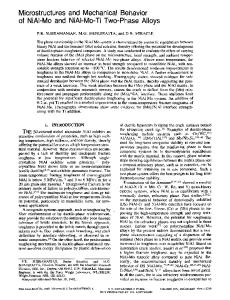Microstructures and Mechanical Behavior of Two-Phase Niobium Silicide-Niobium Alloys
- PDF / 1,514,267 Bytes
- 6 Pages / 420.48 x 639 pts Page_size
- 43 Downloads / 855 Views
MICROSTRUCTURES AND MECHANICAL BEHAVIOR OF TWO-PHASE NIOBIUM SILICIDE-NIOBIUM ALLOYS M.,G. MENDIRATTA* AND D. M. DIMIDUK** *Universal Energy Systems, Inc., Dayton, OH 45432-1894 **AFWAL/MLLM, Wright-Patterson Air Force Base, OH 45433-6533
ABSTRACT In the Nb-Si system, it is possible to produce in-situ composites consisting of a brittle Nb 5 Si 3 intermetallic matrix and ductile Nb particles. The two phases are thermochemically stable up to - 1500'C and are amenable to wide microstructural variations including morphology, volume fraction, and the size of the individual microconstituents. This paper presents microstructures and phase transformations in these composites as a function of composition and heat treatments and bend properties from room-temperature to 1400TC.
INTRODUCTION A majority of intermetallic compounds with high melting temperatures (> 1500*C) have low-symmetry complex crystal structures and are expected to exhibit high elastic stiffness, strength and creep resistance at elevated temperatures. However, these intermetallics have a lack of ductility and extremely low fracture toughness at room temperature. These compounds can be exploited for high-temperature structural use provided their low-temperature toughness or damage-tolerance can be enhanced significantly without compromising the attractive high -temperature properties. Various "composite" approaches may achieve this goal. One of the approaches involves a uniform dispersion of ductile but tough second phase particles in an intermetallic matrix. Toughness enhancement occurs by cracks bridging the ductile particles, thereby shielding the crack tip from the applied stress intensity [1,2]. In addition to the requirement of a balance in mechanical properties, the composite system must exhibit a high degree of thermochemical stability. The Nb-Si phase diagram indicates [21 that the terminal Nb phase and the intermetallic Nb 5 Si 3 are virtually immiscible up to - 1783*C. The variation of Si solubility in Nb with temperature is very small, this variation is negligible in Nb 5 Si 3 . This system thus offers the potential of producing thermochemically stable composites consisting of a ductile refractory metal phase and a strong intermetallic phase. The Nb-Si system provides a model system to understand the correlation of microstructural parameters (i.e., size, volume fraction, morphology and distribution of the two phases) with the low-temperature damage tolerance and high-temperature strength and creep. Research is currently underway on the microstructures and mechanical behavior of the Nb-Nb 5 Si 3 model composites. These composites are being fabricated by three methods: i) arc-melted buttons of varying compositions, ii) rapidly solidified ribbons produced by electron beam melting and splat quenching and iii) mechanical blending of various amounts of Nb and crushed Nb 5 Si 3 powders followed by vacuum hot pressing. This paper presents results on microstructures and phase transformations in the as-melted plus heat treated buttons and rapidly solidifi
Data Loading...











